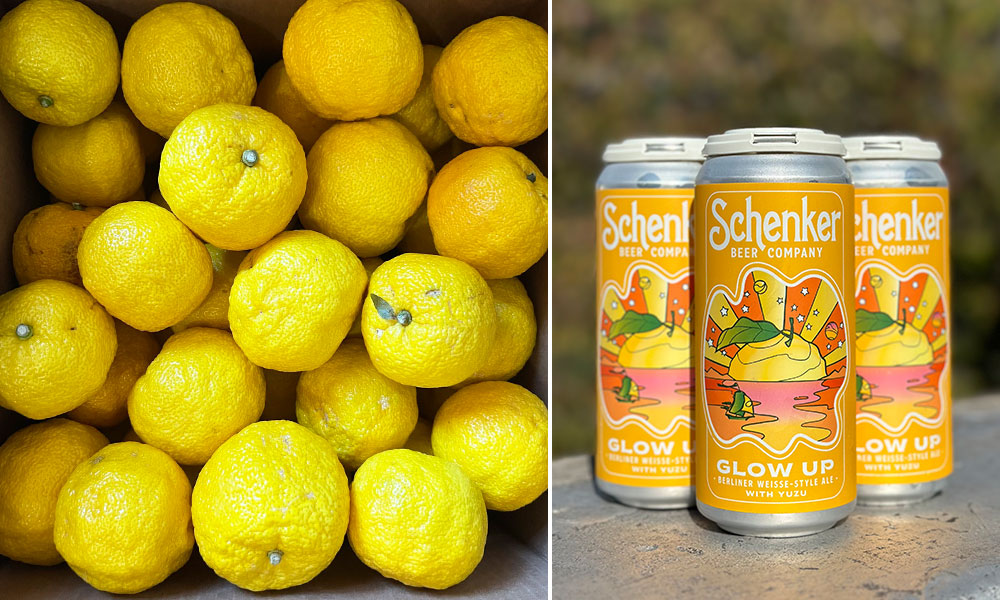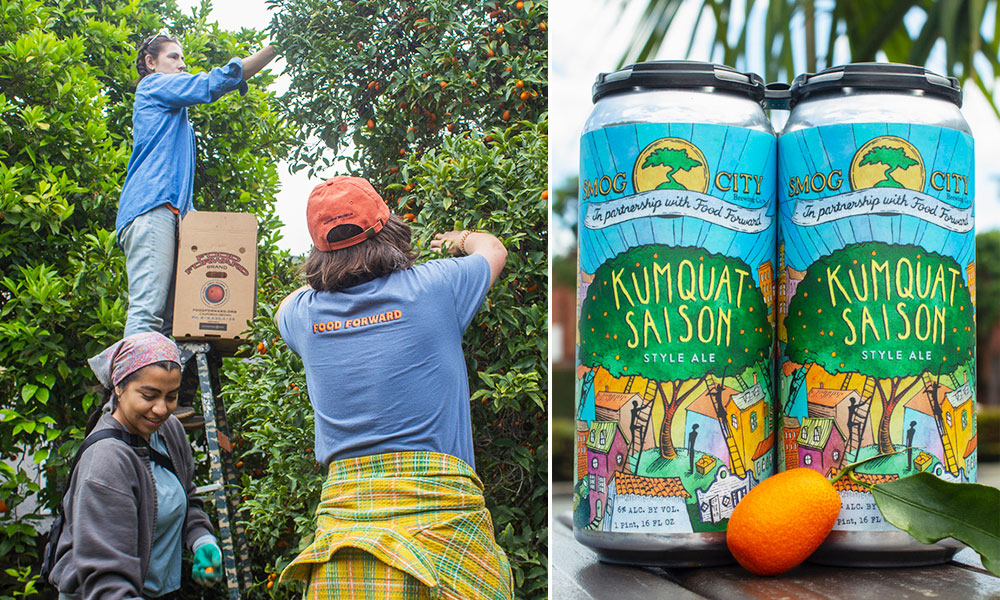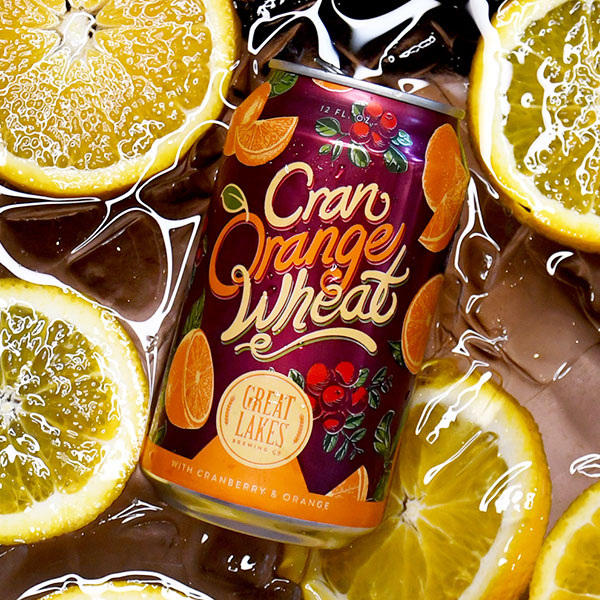Seasonality can shape our romance of local craft beer. The hop harvest in August and September gives us our treasured fresh hop ales, sweeter for their fleeting presence. Simultaneously, some breweries take advantage of pawpaw season (Jackie O’s, Upland Brewing Co., and Fullsteam all highlight the North American, tropical-flavored tree fruit), while throughout the rest of the year, botanically driven beers reveal what herbs were ready to be harvested or foraged when they were brewed.
Somewhere along the way, though, one of the best known, widest ranging flavor profiles in beer lost its seasonal ties: citrus. The main harvest window for citrus fruits runs from November to March, so why isn’t that period an anticipated citrus beer season?
“If you think of a kid running a lemonade stand, you imagine them wearing a T-shirt and shorts, not a jacket,” says Brooklyn Brewery brewmaster Garrett Oliver. Citrus has become somewhat synonymous with summer, with its inherent refreshing qualities, inclusion in beer styles known as easy-drinking thirst-quenchers, and season-less availability for consumers.
“The first thought that comes to mind is Belgian-style witbiers and having dried citrus peel ingrained with that recipe and flavor profile,” says Joey Pepper-Mellusi, owner and brewer at New York’s Schenker Beer Company. “It’s probably the first thing people think of when they think of citrus and beer, like, ‘Oh, citrus, summer beer, witbier.’”
“It’s become an automatic reaction to think of lighter, brighter flavors when it’s warm out,” says Michael Williams, brand coordinator at Great Lakes Brewing Co. in Cleveland. “Then on winter days, it’s colder and darker and people gravitate toward porters, stouts, and winter seasonal beers that reflect the weather.” Plus, Williams explains, while so much of craft beer is rooted in using whatever’s fresh at the time, “we live in a grocery-store world. Consumers have a bit of a disconnect with when citrus is fresh and in season because they’re seeing oranges in stores year-round.”
Capturing the Moment
For breweries such as Great Lakes, Brooklyn Brewery, and Schenker, though, as well as Arizona Wilderness; Smog City City Brewing Co. in Torrance, Calif.; and Fort Point Beer Company in San Francisco, it’s important to embrace the true seasonality of citrus.
For Arizona Wilderness head of production Brad Miles and wood cellar manager Nick Pauley, crafting beers around citrus fruits right when they’re harvested creates an unrivaled experience of freshness. They take full advantage of the season: Miles aims for a citrus beer each month, and this year, there will be seven releases from February to May, such as their popular Arizona Dreamsicle Milkshake IPA, Citrus Valley Triple IPA, and the March for Orange Hazy IPA in support of the Arizona chapter of the MS Society, all with Arizona Sweet oranges; and the Blood Orange Refuge IPA.
They balance regular returning staples with new experiments, demonstrating how many styles citrus shines in. Arizona Dreamsicle and Blood Orange Refuge play on what a natural fit citrus is for IPAs, considering how prominent those notes are in many hops’ aromas. They’ve also brewed citrus lagers and classic witbiers such as the Regenerative Desert Wheat. Pauley says their Salome saison is made with Meyer lemons from a brewery employee’s grandmother’s tree; other beers highlight tangelos, oranges, limes, yuzus, kumquats, and mandoras, which are orange-mandarin hybrids.
“When we’re making these beers in the winter, we’re able to capture the moment when this stuff is at its peak freshness and availability,” Pepper-Mellusi says. He uses lime, mandarin, and yuzu in varying iterations of Schenker’s renowned Glow Up Berliner Weisse series, and feels their flavors shine whether they’re used right after harvesting or frozen at that time to be used later. Once in the beer, citrus boasts staying power, too. “Even three to six months after one of our Glow Ups is packaged, the fruit flavor holds on quite well as opposed to some other fruits that may drop out a bit faster because they don’t have that oil content.”
Building Relationships
Of-the-moment freshness isn’t the only perk of working with citrus in season, says Mike Schnebeck, director of innovation at Fort Point Beer Company. “Focusing on citrus in the wintertime gives you this selection of more interesting varieties … There are more opportunities to work closely with local farmers and folks that really know these varietals, know when things are ripe and when things are going to be the best, and know the nuances of the fruit.” When you source a flavor such as lemon or lime in the summer, he explains, you’re not looking at many specific details because they’re simply not available—you’re shopping from processed or concentrated options, which can yield more broad, less nuanced flavors.
The relationships brewers build with their citrus suppliers is a main driver of their using these fruits in season. Schenker’s citrus beers were born out of Pepper-Mellusi’s relationship with Flavors by Bhumi in Bordentown, N.J., one of the few United States yuzu growers outside of California.
“Working with brewers like Joey is an exciting journey,” says Flavors by Bhumi cofounder Vivek Malik. “They understand how to let the citrus notes shine in a brew, highlighting yuzu’s natural complexity [brewers describe this as grapefruit brightness, lime tartness, mandarin sweetness, and even some bitter pine]. This collaboration allows us to bring the unique characteristics of yuzu to an entirely new audience.”

Arizona Wilderness works primarily with Agritopia, five miles from the brewery in Gilbert. “They grow a certain number of varieties, and we tell them what we want—I heard we bought 85 percent of their citrus last year,” Miles says. When we spoke, he had just handed in his “citrus forecast” to Agritopia, mapping out what fruits they’d need for what beers. While Miles certainly has fruits in mind, especially for regular Arizona Wilderness rotationals, he and Pauley are open to learning about whatever’s being grown—the great thing about citrus fruits, Pauley notes, is that if it tastes good, it’s likely to work well in beer.
Agritopia head farmer Kelly Saxer says about seven of their 11 acres are devoted to citrus and other orchard crops. “Arizona Sweet oranges are mostly what breweries source for their beer; it’s a good juicing orange,” she says. They also grow navel oranges, mandarins, tangelos, tangerines, pomelos, pink grapefruits, white grapefruits, lemons, and blood oranges, “another one breweries like a lot.” Different varieties are ready for harvest at different times, generally beginning to ripen in November and December and continuing to early March, providing a brewery like Arizona Wilderness with a long season of different fruits for different beers.
A supplier relationship is also at the heart of Smog City’s Kumquat Saison. Cofounder and brewmaster Jonathan Porter says inspiration struck in 2015 when he and his wife, Smog City cofounder Laurie Porter, rented a house with a big kumquat tree and realized how well the fruit would work in beer. “It’s delicious and unique in that it doesn’t have segments, and the skin is sweet,” he says. “It’s marmalade-y and overall pretty tart, kind of phenolic, and complex.” They started making 50-gallon batches using a pound of kumquats per gallon, and could do several batches just from that tree. But then they found a local organization called Food Forward, aimed at fighting hunger and preventing food waste through means such as accepting surpluses from personal fruit trees.

“They said the one thing they couldn’t get rid of was kumquats…it was hard to funnel them into food pantry items,” Porter recalls. “That began our partnership with them.” With kumquats harvested all over LA, Smog City can now brew multiple 500-gallon batches of Kumquat Saison, a beer which, according to the brewery’s marketing specialist Brett Ciccarello, is part of their One Percent for the Planet Initiative. Smog City dedicates 1 percent of sales to environmental nonprofits, with Food Forward being one of the organizations they make beer for, donate to, and volunteer with.
Part of the Process
Working with fresh fruits as opposed to year-round concentrates is a chance for brewers to prove their dedication to these flavors’ seasonality. Some suppliers handle the time-consuming processing of the fruit themselves—for its Yuzu KSA Radler, Fort Point gets juice made by Yuzuco from fresh yuzus. The juice’s perks over concentrates are clear, Schnebeck says, in the depth and complexity of the flavors, which even feature some piney-ness.
Other brewers handle this processing in-house. Miles says they’ve found they need to use all parts of the fruit to represent its complexity, from the sweet juice to the bitter-tinged peel. They use an industrial juicer to cut fruits in half, squeeze them, and discard too-bitter pith so they just have zesty peel. For the same complexity-geared reason, Oliver uses grapefruits in their entirety for Brooklyn Brewery’s non-alcoholic Special Effects Grapefruit IPA.
At Smog City, the team freezes the kumquats until they’ve got enough for a batch, then they carefully thaw them and use a giant immersion blender to grind them up. What Porter calls a “coarse puree” of peel, pulp, seeds, and all goes on top of the saison when it’s past its primary fermentation.
Most brewers tend to add their citrus later in the brewing process because, as Pepper-Mellusi notes, volatile aromas can get lost on the hot side, a waste when you’re working with whole, fresh fruits, especially pricier ones like yuzus. “Putting yuzu in more toward the conditioning stage allows it to go further…and carry through aromatically.”
For the Cran Orange Wheat at Great Lakes, Williams says their orange also goes in pretty late. “The puree is going into the whirlpool to prevent volatilizing some of those flavor compounds, and then later we stuff a hop bag with the peel…it creates the perception of real fruit character, with some very light astringency from the peel that’s not too in your face.”
Keeping the Sun in Your Heart
Another challenge in making citrus beers in the winter can be reminding consumers why they want these flavors even if it’s cold out, but this is something made increasingly easy with the reputations these brewers have developed, the strong reception their beers have been met with, and some helpful seasonal connections.

The Cran Orange Wheat, for example, is part of a holiday-geared lineup for Great Lakes including their renowned Christmas Ale and a cookie stout. With its wheat beer base, it’s a refreshing way to present citrus for winter, playing on the Christmas tradition of an orange in your stocking and cranberry sauce on the dinner table. The beer itself, Williams says, pairs well with food, especially as a way to cut through and brighten those richer dishes.
At Fort Point, the team hadn’t even planned a specific season for the Yuzu KSA Radler to be available, but the demand was so great for it upon its debut in June that they decided to make it available in the winter and all year round. Even with colder winters in New York, Pepper-Mellusi observes that some drinkers don’t entirely switch their preferences based on the weather. Just as some breweries make stouts in the summer, breweries who release citrus wheat beers, sours, and Kölsches in winter instantly become a go-to for the consumers craving those brighter beers in December. That flavor profile, too, can prove transformative in dreary winters that tend to otherwise come with heavier flavors.
“I feel like humans in general crave citrus in winter months because of the lack of sunshine,” Porter says—even in Southern California. “If we don’t get [that brightness] from the sun, we get it on the palate.”
“My brother Roger and I have a phrase we always use, and that is, ‘You have to keep the sun in your heart,’” Oliver says. “We say that to ourselves as we return to cold, dark NYC after two weeks on warm, sunny Mexican beaches in February. So, while a citrus beer isn’t as obvious in winter, they’re still delicious. It’s all about the mindset, and summer is a state of mind.”
The post Citrus Sunshine in the Cold Winter appeared first on CraftBeer.com.
